A High Performance Optimizing Method for Modeling Photovoltaic Cells and Modules Array Based on Discrete Symbiosis Organism Search
Abstract
:1. Introduction
- The prerequisite of this algorithm was that it did not need to find a good set of parameters.
- It did not need any specific parameter requirement to be tuned like the genetic algorithm, which needs at least a cross over type, cross over rate adjustment, and % of mutation rate.
- Finding the appropriate interval for each solution takes additional cost in time and computing; that is not necessary in the case of DSOS the search space of the algorithm can be more width.
2. Mathematical Models of PV Systems
2.1. Single Diode Model Formulation (SDM)
2.2. Extracting the Five Parameters Under the Standard Test Conditionsfor the Single Diode Model
2.3. Extracting the Seven Parameters Under the STC Double Diode Model
3. Methodology of the Symbiosis Organism Search (DSOS) Algorithm
3.1. Main Idea of the Discrete Symbiotic Organisms Search (DSOS)
3.2. Flowchart of the DSOS
3.3. The Discrete Symbiotic Organisms Search Algorithm (DSOS)
- Determine the best organism,
- Mutualism phase: % interaction benefit for both sides,
- Commensalism phase: % benefit to one side and the other side is neutral.
- Parasitism phase: % benefit to one side and the other is well harmed.
3.3.1. Mutualism
3.3.2. Commensalism
3.3.3. Parasitism
3.4. Computation Procedure of the DSOS Algorithm
| Algorithm 1 Code of the DSOS algorithm |
| Define an objective function f(X); X = (x1, x2, x3,…,xd) %d is the dimension % of the problem Inputs: ecosystem/population size and the objective function Initialize an ecosystem of n organisms with a random solution. % Initialize the organism randomly in the ecosystem % Evaluate the fitness of the new solution % Increase the number of function evaluation count. While (t < Ecosystem) For i = 1:n % n is the number of organisms Find the best organism in the ecosystem Xbest % Mutation phase Randomly select one organism Xj, where Xi # Xj Determine the mutual relationship vector (Mutual-Vector) and the benefit factor (BF). Modify organism Xi and Xj using Equations (12)–(14). If the modified organism gives a better fitness evaluation than the previous one, then update them in the ecosystem. % Commensalism phase Randomly select one organism Xj, where Xi # Xj Modify organism Xi and Xj using Equation (15) If the modified organism gives a better fitness evaluation than the previous: then update them in the ecosystem. % Parasitism phase Randomly select one organism Xj, where Xi # Xj Generate a parasite vector from organism Xi (Equation (15)) If the parasite-vector gives a better fitness evaluation than Xj, then replace it with the parasite-vector in the ecosystem. End for Then the Global Best solution is saved as an optimal solution; End while |
3.5. Formulation of the SDM Solar Cell Parameter Estimation Problem
3.5.1. Single Diode Model Formulation SDM
3.5.2. Double Diode Model Formulation (DDM)
3.6. Parameter Optimization Problem for SDM and DDM
3.7. Symbiosis Organism Search Implementation
3.8. Measurement and Experiment Results
3.8.1. Simulation and experimental results of the Single Diode Model
3.8.2. Simulation and experimental results of the Double Diode Model
4. Results
5. Discussion
6. Conclusions
Author Contributions
Funding
Conflicts of Interest
References
- Bouali, C.; Marouani, R.; Schulte, H.; Mami, A. Photovoltaic System Enhancing Power Quality of Electrical Network. Int. J. Energy Convers. 2019, 7, 1–11. [Google Scholar] [CrossRef]
- Ismail, M.S.; Moghavvemi, M.; Mahlia, T.M.I. Characterization of PV panel and global optimization of its model parameters using genetic algorithm. Energy Convers. Manag. 2013, 73, 10–25. [Google Scholar] [CrossRef]
- Nunes, H.G.G.; Pombo, J.A.N.; Mariano, S.; Calado, M.R.A.; de Souza, J.F. A new high performance method for determining the parameters of PV cells and modules based on guaranteed convergence particle swarm optimization. Appl. Energy 2018, 211, 774–791. [Google Scholar] [CrossRef]
- El Tayyan, A.A. An approach to extract the parameters of solar cells from their illuminated I—V curves using the Lambert W function. Turk. J. Phys. 2015, 39, 1–15. [Google Scholar] [CrossRef]
- Chan, D.S.H.; Phang, J.C.H. Analytical methods for the extraction of solar-cell single- and double-diode model parameters from I-V characteristics. IEEE Trans. Electron Devices 1987, 34, 286–293. [Google Scholar] [CrossRef]
- Farivar, G.; Asaei, B. A new approach for solar module temperature estimation using the simple diode model. IEEE Trans. Energy Convers. 2011, 26, 1118–1126. [Google Scholar] [CrossRef]
- Wolf, P.; Benda, V. Identification of PV solar cells and modules parameters by combining statistical and analytical methods. Sol. Energy 2013, 93, 151–157. [Google Scholar] [CrossRef]
- Phang, J.C.H.; Chan, D.S.H.; Phillips, J.R. Accurate analytical method for the extraction of solar cell model parameters. Electron. Lett. 1984, 20, 406–408. [Google Scholar] [CrossRef]
- Reis, L.R.D.; Camacho, J.R.; Novacki, D.F. The Newton Raphson Method in the Extraction of Parameters of PV Modules. In Proceedings of the International Conference on Renewable Energies and Power Quality (ICREPQ’17), Malaga, Spain, 4–6 April 2017. [Google Scholar]
- Tamrakar, R.; Gupta, A. Extraction of Solar Cell Modelling Parameters Using Differential Evolution Algorithm. IJIREEICE 2015, 3. [Google Scholar] [CrossRef]
- Maherchandani, J.K.; Agarwal, C.; Sahi, M. Estimation of Solar Cell Model Parameter by Hybrid Genetic Algorithm Using MATLAB. Int. J. Adv. Res. Comput. Eng. Technol. 2012, 1, 78–81. [Google Scholar]
- Mohapatra, A.; Nayak, B.; Mohanty, K.B. Parameter estimation of single diode PV module based on Nelder-Mead optimization algorithm. World J. Eng. 2018, 15, 70–81. [Google Scholar] [CrossRef]
- Jadli, U.; Thakur, P.; Shukla, R.D. A New Parameter Estimation Method of Solar Photovoltaic. IEEE J. Photovolt. 2018, 8, 239–247. [Google Scholar] [CrossRef]
- Chin, V.J.; Salam, Z.; Ishaque, K. An Accurate and fast computational algorithm for the two-diode model of PV module based on a hybrid method. IEEE Trans. Ind. Electron. 2017, 64, 6212–6222. [Google Scholar] [CrossRef]
- Ouchen, S.; Betka, A.; Abdeddaim, S.; Menadi, A. Fuzzy-predictive direct power control implementation of a grid connected photovoltaic system, associated with an active power filter. Energy Convers. Manag. 2016, 122, 515–525. [Google Scholar] [CrossRef]
- Ram, J.P.; Manghani, H.; Pillai, D.S.; Babu, T.S.; Miyatake, M.; Rajasekar, N. Analysis on solar PV emulators: A review. Renew. Sustain. Energy Rev. 2018, 81, 149–160. [Google Scholar] [CrossRef]
- Bonkoungou, D.; Koalaga, Z.; Njomo, D. Modelling and Simulation of photovoltaic module considering single-diode equivalent circuit model in MATLAB. Int. J. Emerg. Technol. Adv. Eng. 2013, 3, 493–502. [Google Scholar]
- Askarzadeh, A.; Coelho, L.d.S. Determination of photovoltaic modules parameters at different operating conditions using a novel bird mating optimizer approach. Energy Convers. Manag. 2015, 89, 608–614. [Google Scholar] [CrossRef]
- Elazab, O.S.; Hasanien, H.M.; Elgendy, M.A.; Abdeen, A.M. Whale optimisation algorithm for photovoltaic model identification. J. Eng. 2017, 2017, 1906–1911. [Google Scholar] [CrossRef]
- Appelbaum, J.; Peled, A. Parameters extraction of solar cells—A comparative examination of three methods. Sol. Energy Mater. Sol. Cells 2014, 122, 164–173. [Google Scholar] [CrossRef]
- Dongue, S.B.; Njomo, D.; Ebengai, L. An improved nonlinear five-point model for photovoltaic modules. Int. J. Photoenergy 2013, 2013. [Google Scholar] [CrossRef]
- Montes-Romero, J.; Almonacid, F.; Theristis, M.; de la Casa, J.; Georghiou, G.E.; Fernández, E.F. Comparative analysis of parameter extraction techniques for the electrical characterization of multi-junction CPV and m-Si technologies. Sol. Energy 2018, 160, 275–288. [Google Scholar] [CrossRef]
- Gao, X.; Cui, Y.; Hu, J.; Xu, G.; Wang, Z.; Qu, J.; Wang, H. Parameter extraction of solar cell models using improved shuffled complex evolution algorithm. Energy Convers. Manag. 2018, 157, 460–479. [Google Scholar] [CrossRef]
- Ishaque, K.; Salam, Z. A comprehensive MATLAB Simulink PV system simulator with partial shading capability based on two-diode model. Sol. Energy 2011, 85, 2217–2227. [Google Scholar] [CrossRef]
- Ayodele, T.R.; Ogunjuyigbe, A.S.O.; Ekoh, E.E. Evaluation of numerical algorithms used in extracting the parameters of a single-diode photovoltaic model. Sustain. Energy Technol. Assess. 2016, 13, 51–59. [Google Scholar] [CrossRef]
- Ishaque, K.; Salam, Z.; Taheri, H. Simple, fast and accurate two-diode model for photovoltaic modules. Sol. Energy Mater. Sol. Cells 2011, 95, 586–594. [Google Scholar] [CrossRef]
- Tong, N.T.; Pora, W. A parameter extraction technique exploiting intrinsic properties of solar cells. Appl. Energy 2016, 176, 104–115. [Google Scholar] [CrossRef] [Green Version]
- Saloux, E.; Teyssedou, A.; Sorin, M. Explicit model of photovoltaic panels to determine voltages and currents at the maximum power point. Sol. Energy 2011, 85, 713–722. [Google Scholar] [CrossRef]
- Chouder, A.; Silvestre, S.; Sadaoui, N.; Rahmani, L. Modeling and simulation of a grid connected PV system based on the evaluation of main PV module parameters. Simul. Model. Pract. Theory 2012, 20, 46–58. [Google Scholar] [CrossRef]
- Bellia, H.; Youcef, R.; Fatima, M. A detailed modeling of photovoltaic module using MATLAB. NRIAG J. Astron. Geophys. 2014, 3, 53–61. [Google Scholar] [CrossRef] [Green Version]
- Scolari, E.; Reyes-Chamorro, L.; Sossan, F.; Paolone, M. A Comprehensive Assessment of the Short-Term Uncertainty of Grid-Connected PV Systems. IEEE Trans. Sustain. Energy 2018, 9, 1458–1467. [Google Scholar] [CrossRef]
- Yang, X. Firefly Algorithm, 2nd ed.; Luniver Press: Bristol, UK, 2010. [Google Scholar]
- Moldovan, N.; Picos, R.; Garcia-Moreno, E. Parameter extraction of a solar cell compact model usign genetic algorithms. In Proceedings of the 2009 Spanish Conference on Electron Devices, Santiago de Compostela, Spain, 11–13 February 2009; pp. 379–382. [Google Scholar]
- Dkhichi, F.; Oukarfi, B.; Fakkar, A.; Belbounaguia, N. Parameter identification of solar cell model using Levenberg–Marquardt algorithm combined with simulated annealing. Sol. Energy 2014, 110, 781–788. [Google Scholar] [CrossRef]
- Lin, P.; Cheng, S.; Yeh, W.; Chen, Z.; Wu, L. Parameters extraction of solar cell models using a modified simplified swarm optimization algorithm. Sol. Energy 2017, 144, 594–603. [Google Scholar] [CrossRef]
- Cheng, M.Y.; Prayogo, D. Symbiotic Organisms Search: A new metaheuristic optimization algorithm. Comput. Struct. 2014, 139, 98–112. [Google Scholar] [CrossRef]
- Yousri, D.A.; AbdelAty, A.M.; Said, L.A.; AboBakr, A.; Radwan, A.G. Biological inspired optimization algorithms for cole-impedance parameters identification. AEU Int. J. Electron. Commun. 2017, 78, 79–89. [Google Scholar] [CrossRef]
- Askarzadeh, A.; Rezazadeh, A. Artificial bee swarm optimization algorithm for parameters identification of solar cell models. Appl. Energy 2013, 102, 943–949. [Google Scholar] [CrossRef]
- Guo, L.; Meng, Z.; Sun, Y.; Wang, L. Parameter identification and sensitivity analysis of solar cell models with cat swarm optimization algorithm. Energy Convers. Manag. 2016, 108, 520–528. [Google Scholar] [CrossRef]
- Yang, X.-S. Firefly algorithm, stochastic test functions and design optimisation. arXiv, 2010; arXiv:1003.1409. [Google Scholar] [CrossRef]
- Mishra, S.; Ray, P.K.; Dash, S.K. A TLBO optimized photovoltaic fed DSTATCOM for power quality improvement. In Proceedings of the 2016 IEEE 1st International Conference on Power Electronics, Intelligent Control and Energy Systems (ICPEICES), Delhi, India, 4–6 July 2016. [Google Scholar]
- Niu, Q.; Zhang, H.; Li, K. ScienceDirect An improved TLBO with elite strategy for parameters identification of PEM fuel cell and solar cell models. Int. J. Hydrogen Energy 2013, 39, 3837–3854. [Google Scholar] [CrossRef]
- Chen, X.; Yu, K.; Du, W.; Zhao, W.; Liu, G. Parameters identi fi cation of solar cell models using generalized oppositional teaching learning based optimization. Energy 2016, 99, 170–180. [Google Scholar] [CrossRef]
- Oliva, D.; Abd, M.; Aziz, E.; Ella, A. Parameter estimation of photovoltaic cells using an improved chaotic whale optimization algorithm. Appl. Energy 2017, 200, 141–154. [Google Scholar] [CrossRef]
- Marzband, M.; Azarinejadian, F.; Savaghebi, M.; Pouresmaeil, E.A.C. Smart transactive energy framework in grid-connected multiple home microgrids under independent and coalition operations. Renew. Energy 2018, 126, 95–106. [Google Scholar] [CrossRef]
- Humada, A.M.; Hojabri, M.; Mekhilef, S.; Hamada, H.M. Solar cell parameters extraction based on single and double-diode models: A review. Renew. Sustain. Energy Rev. 2016, 56, 494–509. [Google Scholar] [CrossRef]
- Easwarakhanthan, T.; Bottin, J.; Bouhouch, I.; Boutrit, C. Nonlinear Minimization Algorithm for Determining the Solar Cell Parameters with Microcomputers. Int. J. Sol. Energy 1986, 1, 1–2. [Google Scholar] [CrossRef]
- Cubas, J.; Pindado, S.; Victoria, M. On the analytical approach for modeling photovoltaic systems behavior. J. Power Sources 2014, 247, 467–474. [Google Scholar] [CrossRef] [Green Version]
- Zagrouba, M.; Sellami, A.; Bouaïcha, M.; Ksouri, M. Identification of PV solar cells and modules parameters using the genetic algorithms: Application to maximum power extraction. Sol. Energy 2010, 84, 860–866. [Google Scholar] [CrossRef]
- Alrashidi, M.R.; Alhajri, M.F. Simulated Annealing algorithm for photovoltaic parameters identification. Sol. Energy 2012, 86, 266–274. [Google Scholar]
- AlHajri, M.F.; El-Naggar, K.M.; AlRashidi, M.R.; Al-Othman, A.K. Optimal extraction of solar cell parameters using pattern search. Renew. Energy 2012, 44, 238–245. [Google Scholar] [CrossRef]
- Hachana, O.; Hemsas, K.E.; Tina, G.M.; Ventura, C. Comparison of different metaheuristic algorithms for parameter identification of photovoltaic cell/module. J. Renew. Sustain. Energy 2013, 5, 053122. [Google Scholar] [CrossRef]
- Wei, H.; Cong, J.; Lingyun, X. Extracting Solar Cell Model Parameters Based on Chaos Particle Swarm Alogorithm. In Proceedings of the 2011 International Conference on Electric Information and Control Engineering, Wuhan, China, 15–17 April 2011; p. 4. [Google Scholar]
- Askarzadeh, A.; Rezazadeh, A. Parameter identification for solar cell models using harmony search-based algorithms. Sol. Energy 2012, 86, 3241–3249. [Google Scholar] [CrossRef]
- Lian, L.; Maskell, D.L.; Patra, J.C. Parameter estimation of solar cells and modules using an improved adaptive differential evolution algorithm. Appl. Energy 2013, 112, 185–193. [Google Scholar]
- Alrashidi, M.R.; Alhajri, M.F. A new estimation approach for determining the I—V characteristics of solar cells. Sol. Energy 2011, 85, 1543–1550. [Google Scholar] [CrossRef]
- Gong, H.; Leng, Y.; Yan, Y.; Peng, W.; Hu, W.; Zeng, Y. Evolutionary algorithm and parameters extraction for dye-sensitised solar cells one-diode equivalent circuit model. Micro. Nano Lett. 2013, 8, 86–89. [Google Scholar]
- Rekioua, D.; Matagne, E. Optimization of Photovoltaic Power Systems Modelization, Simulation and Control; Library of Congress Control Number: 2011942409; Springer: London, UK; Dordrecht, The Netherlands; Heidelberg, Germany; New York, NY, USA, 2012. [Google Scholar]
- Bouzidi, K.; Chegaar, M.Ã.; Bouhemadou, A. Solar cells parameters evaluation considering the series and shunt resistance. Sol. Energy Mater. Sol. Cells 2007, 91, 1647–1651. [Google Scholar] [CrossRef]
- Babu, T.S.; Priya, K.; Rajasekar, N.; Balasubramanian, K. An innovative method for solar pv parameter extraction for double diode model. In Proceedings of the 12th IEEE International Conference Electronics, Energy, Environment, Communication, Computer, Control: (E3-C3), INDICON 2015, New Delhi, India, 17–20 December 2015. [Google Scholar]

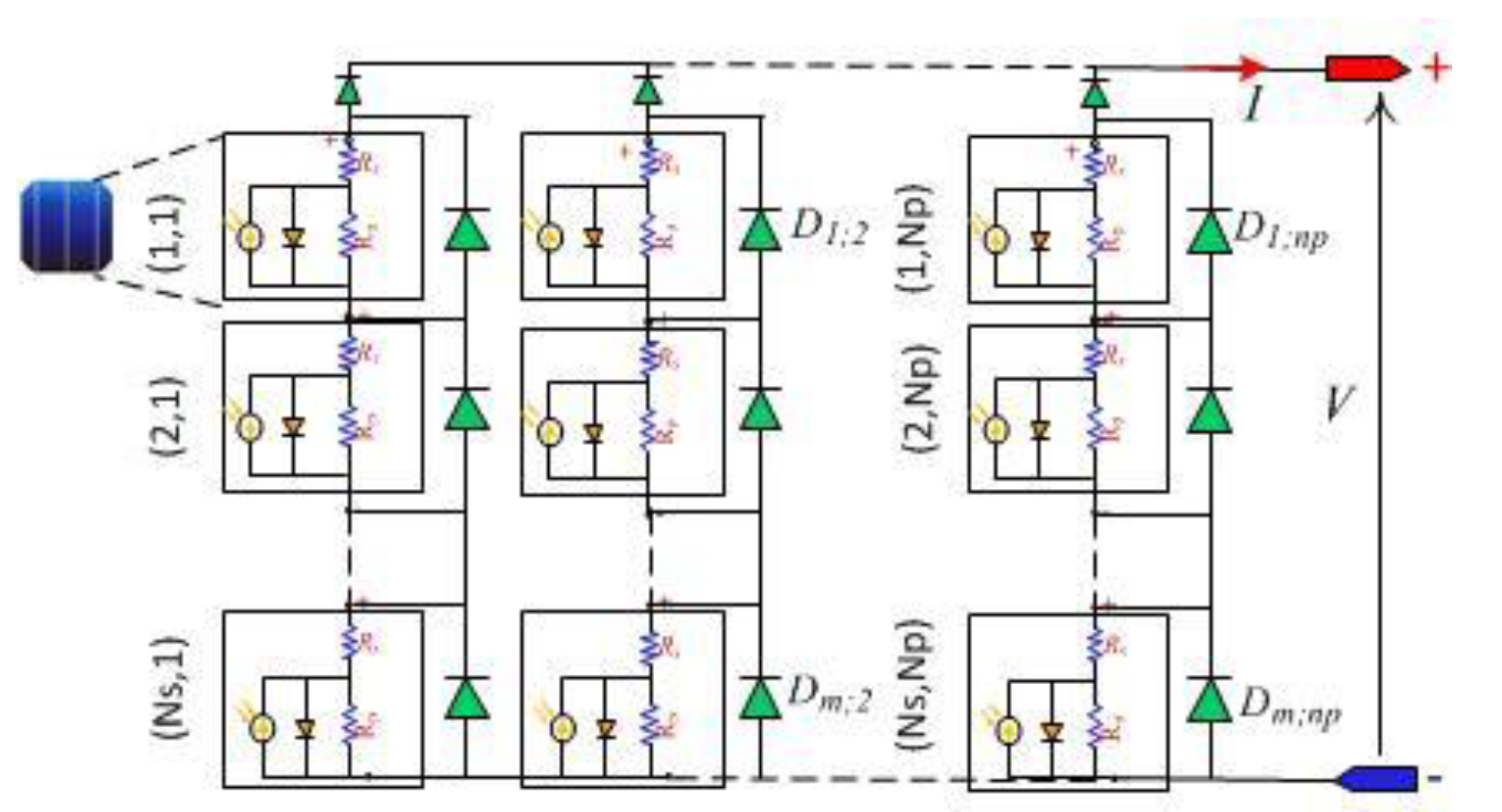
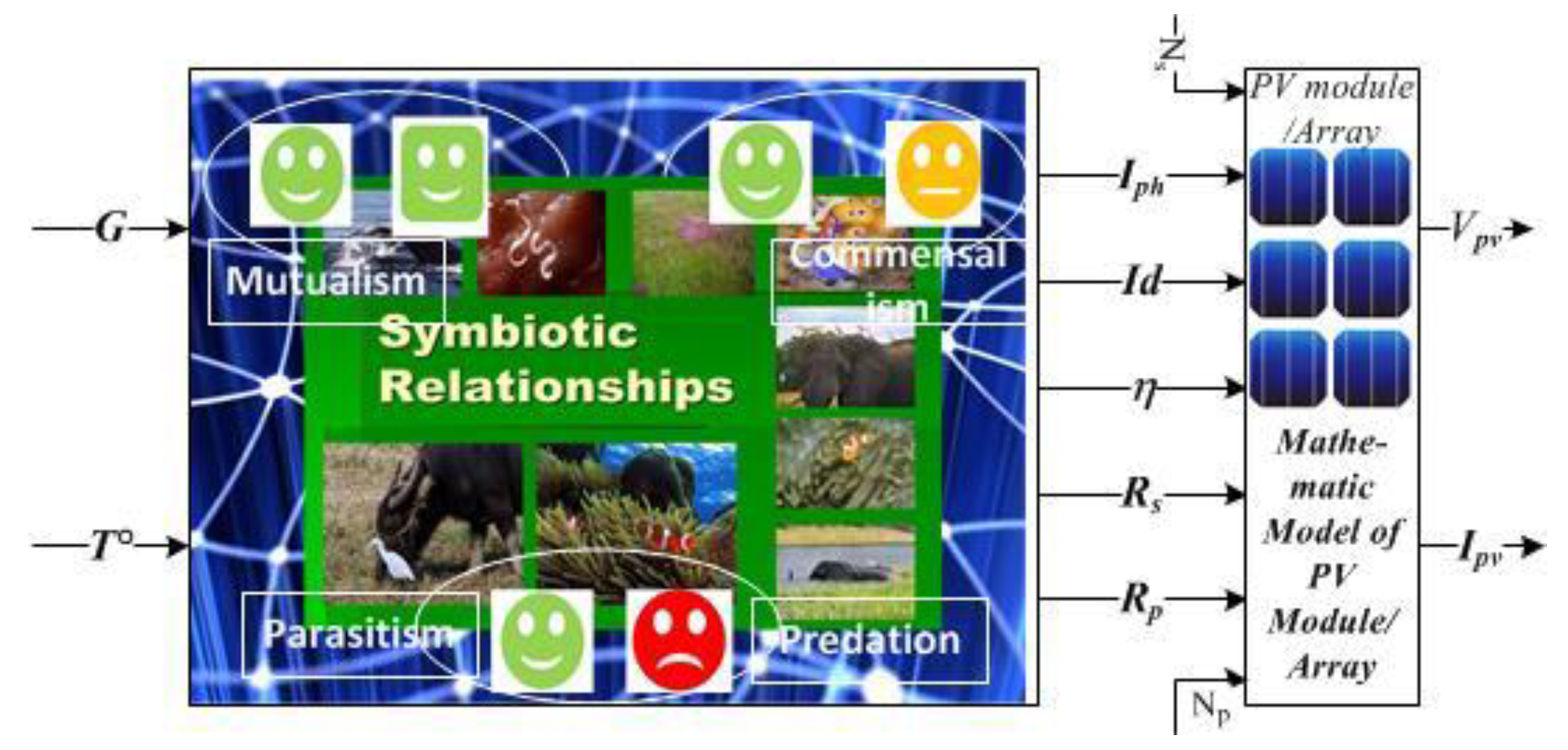
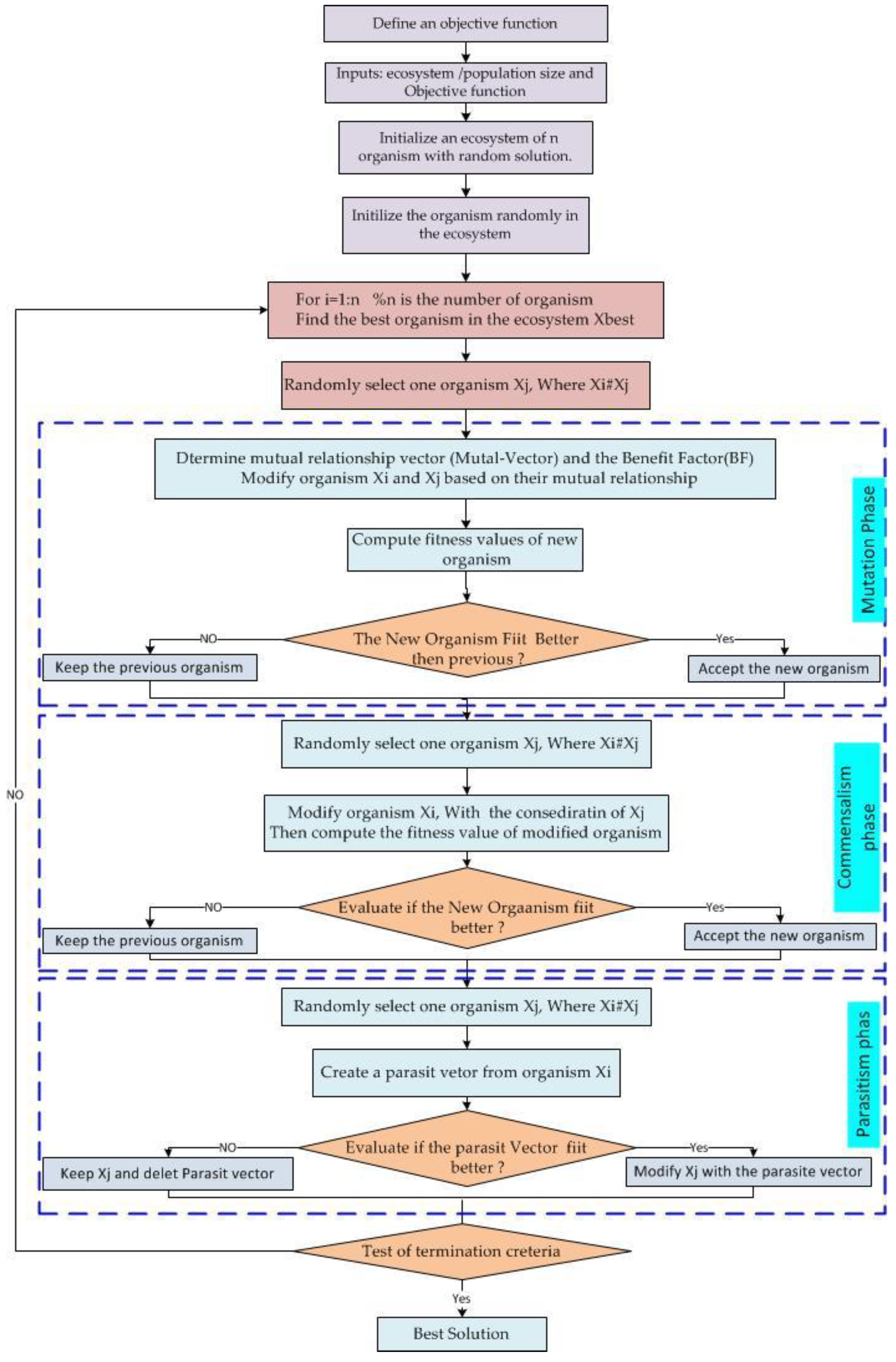
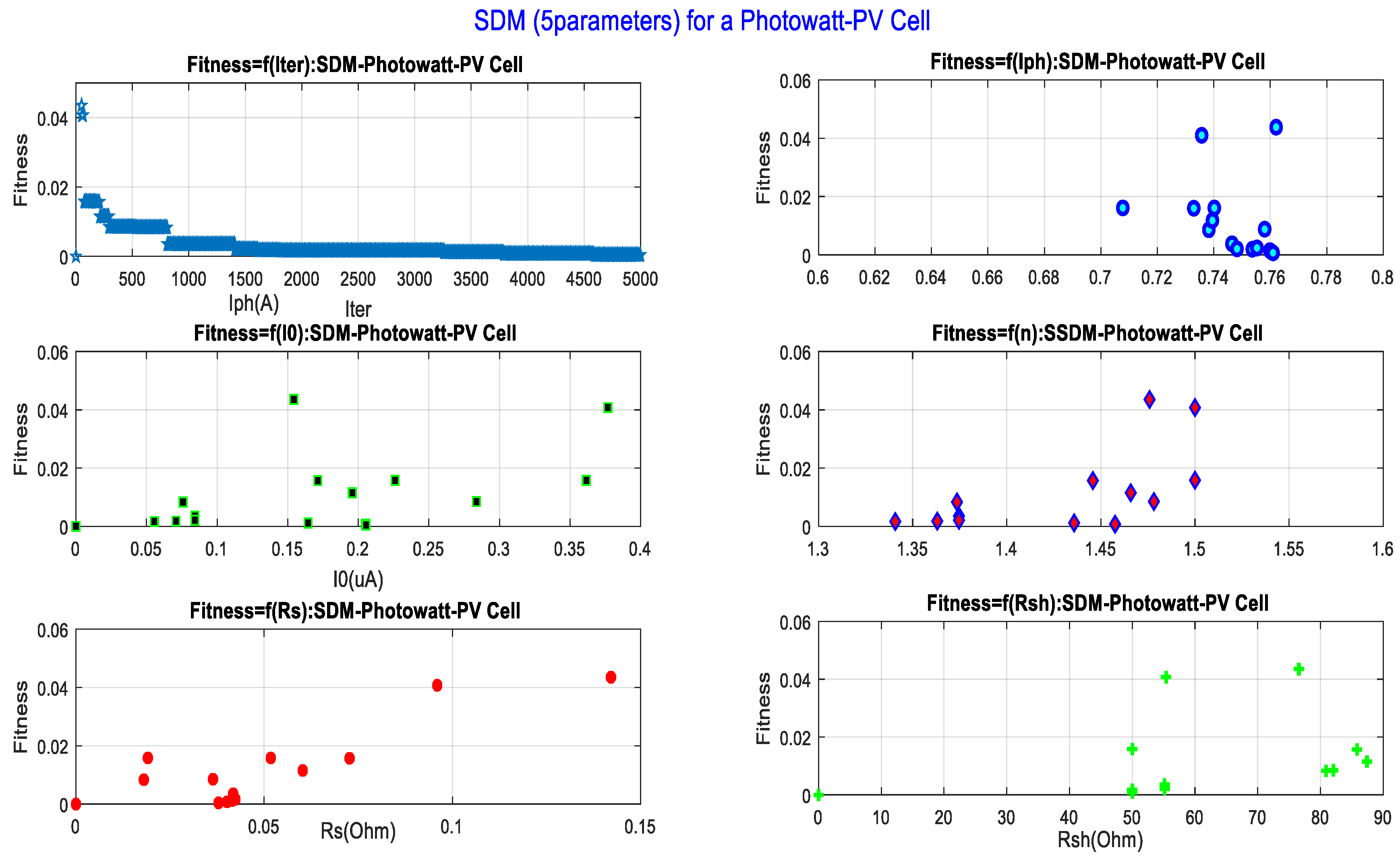

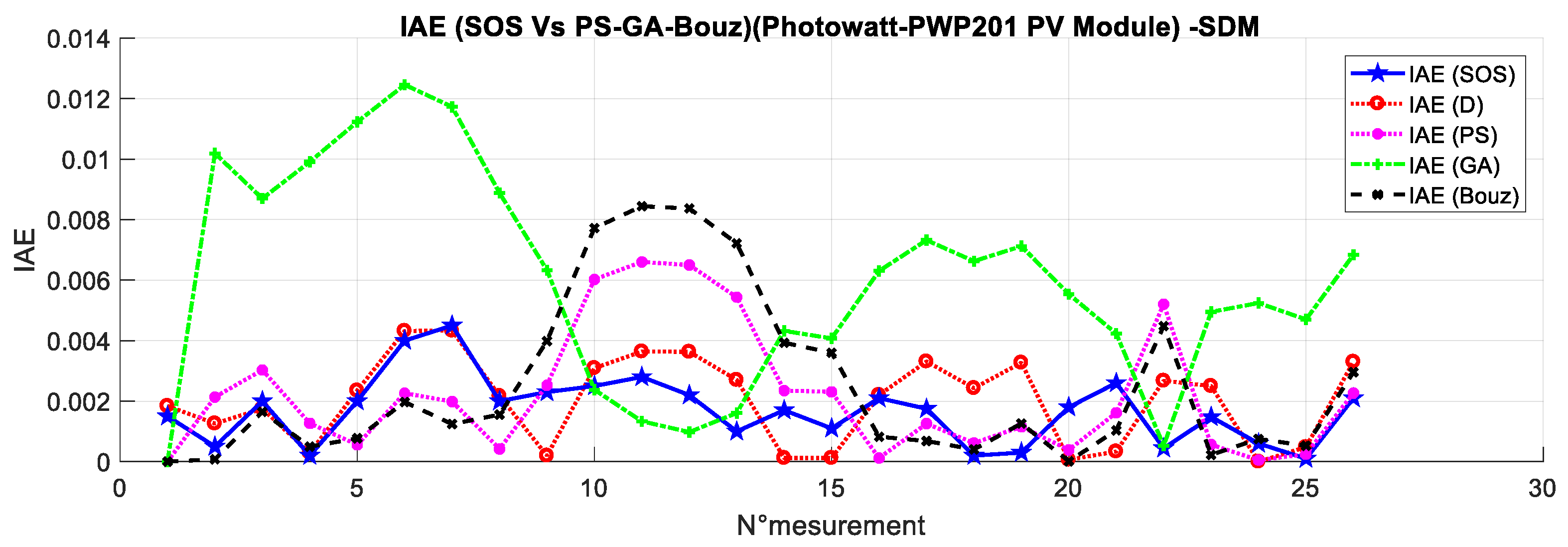
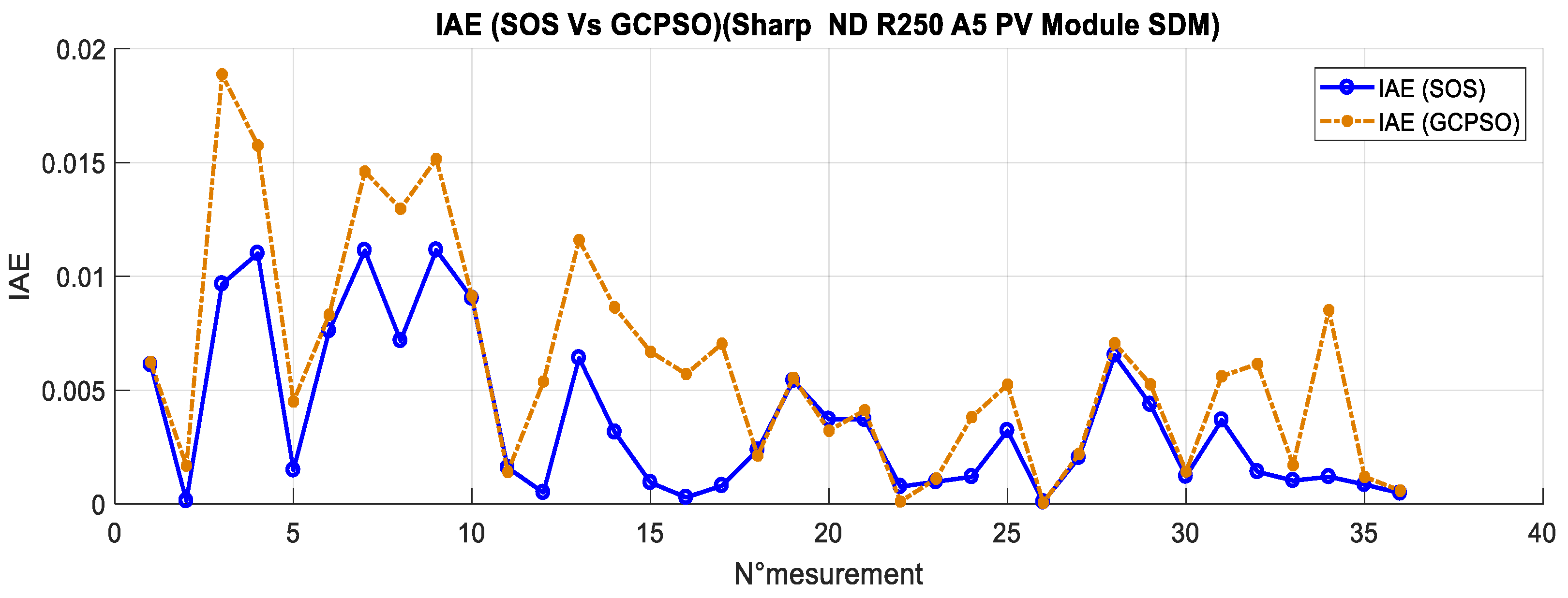

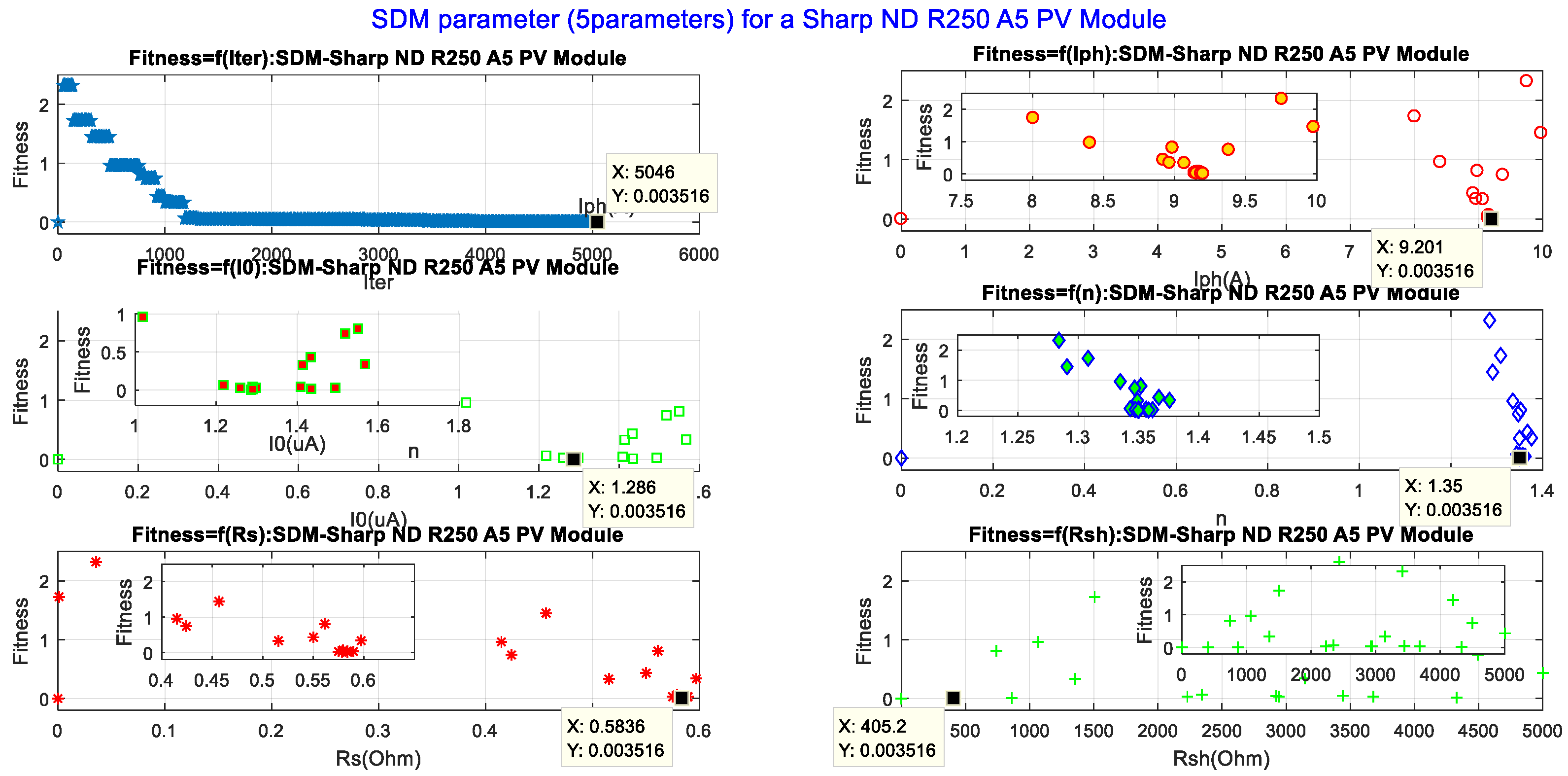


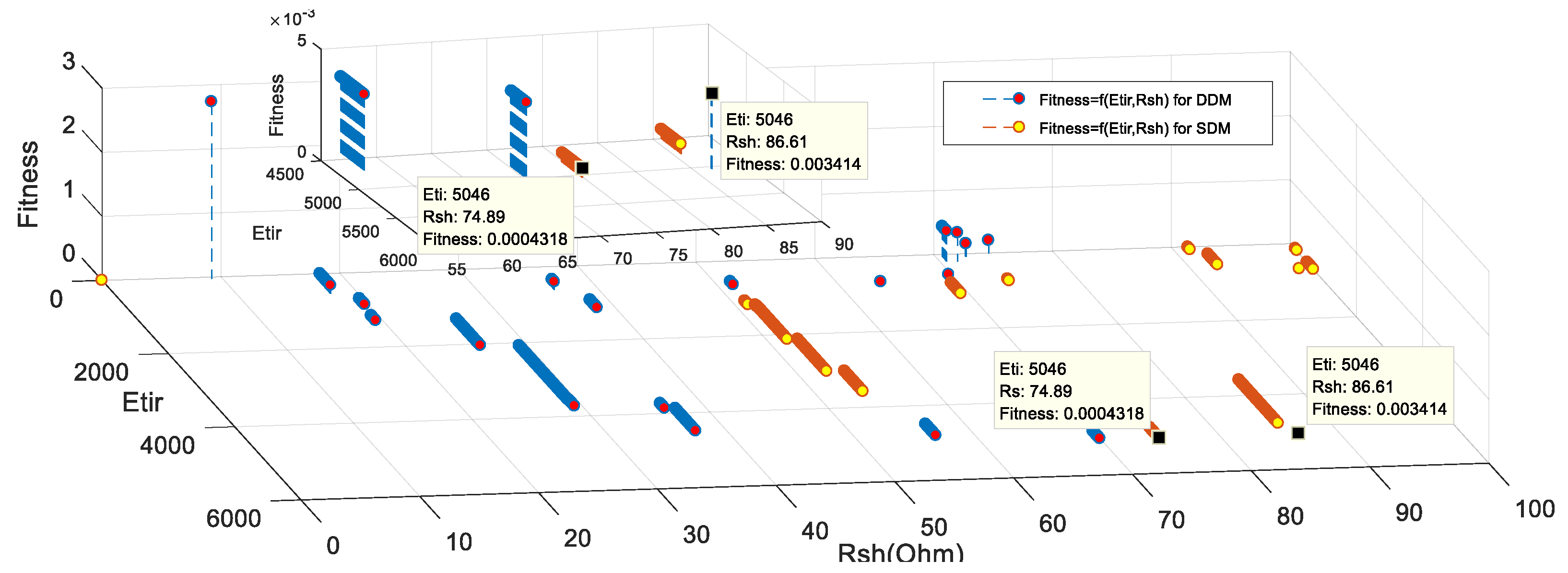
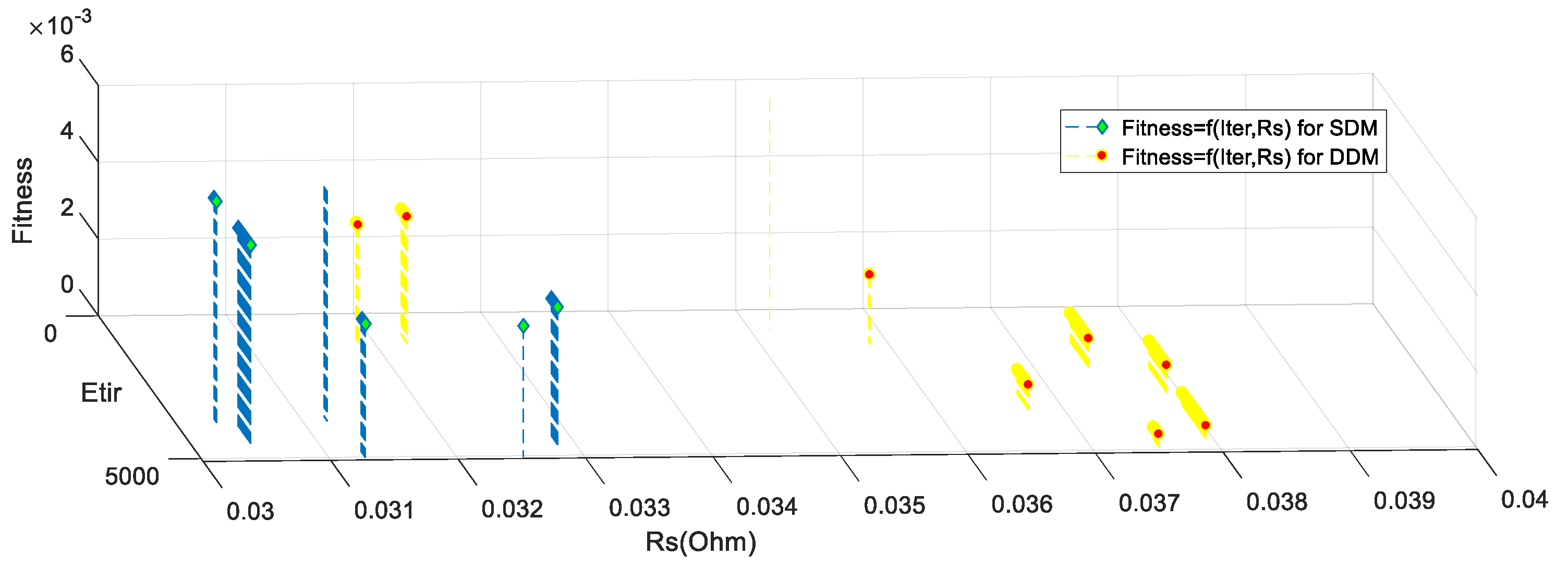

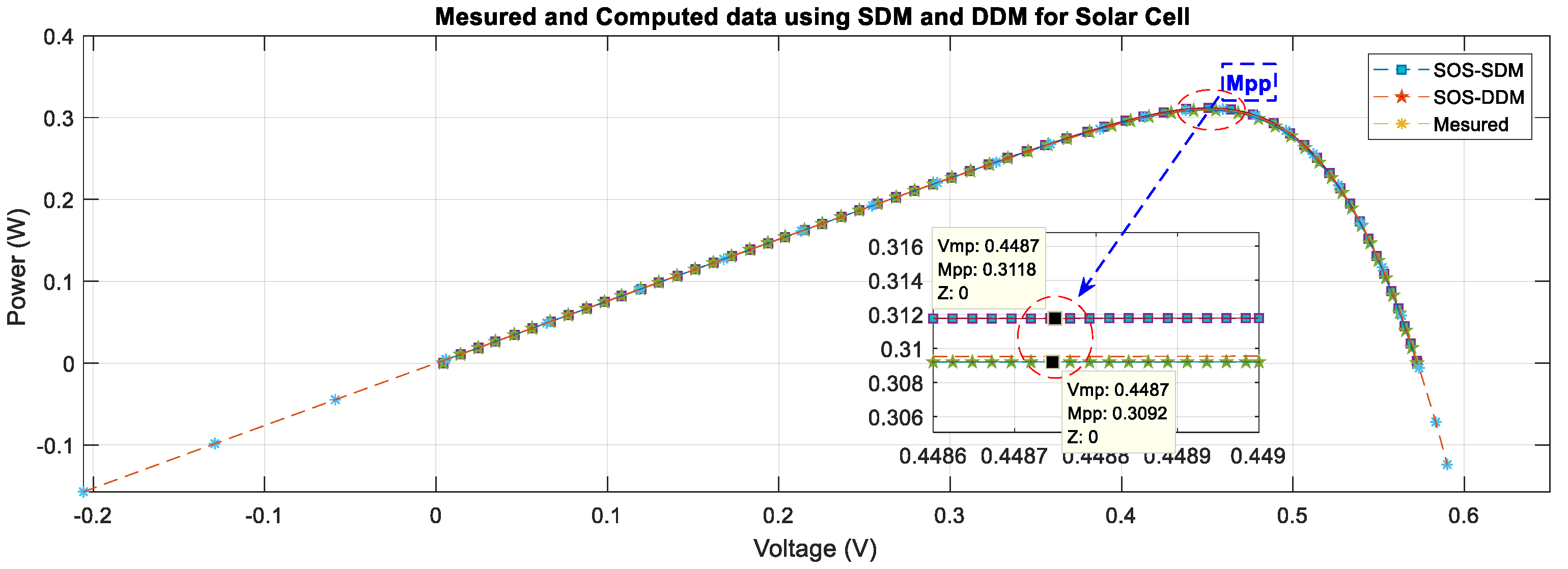
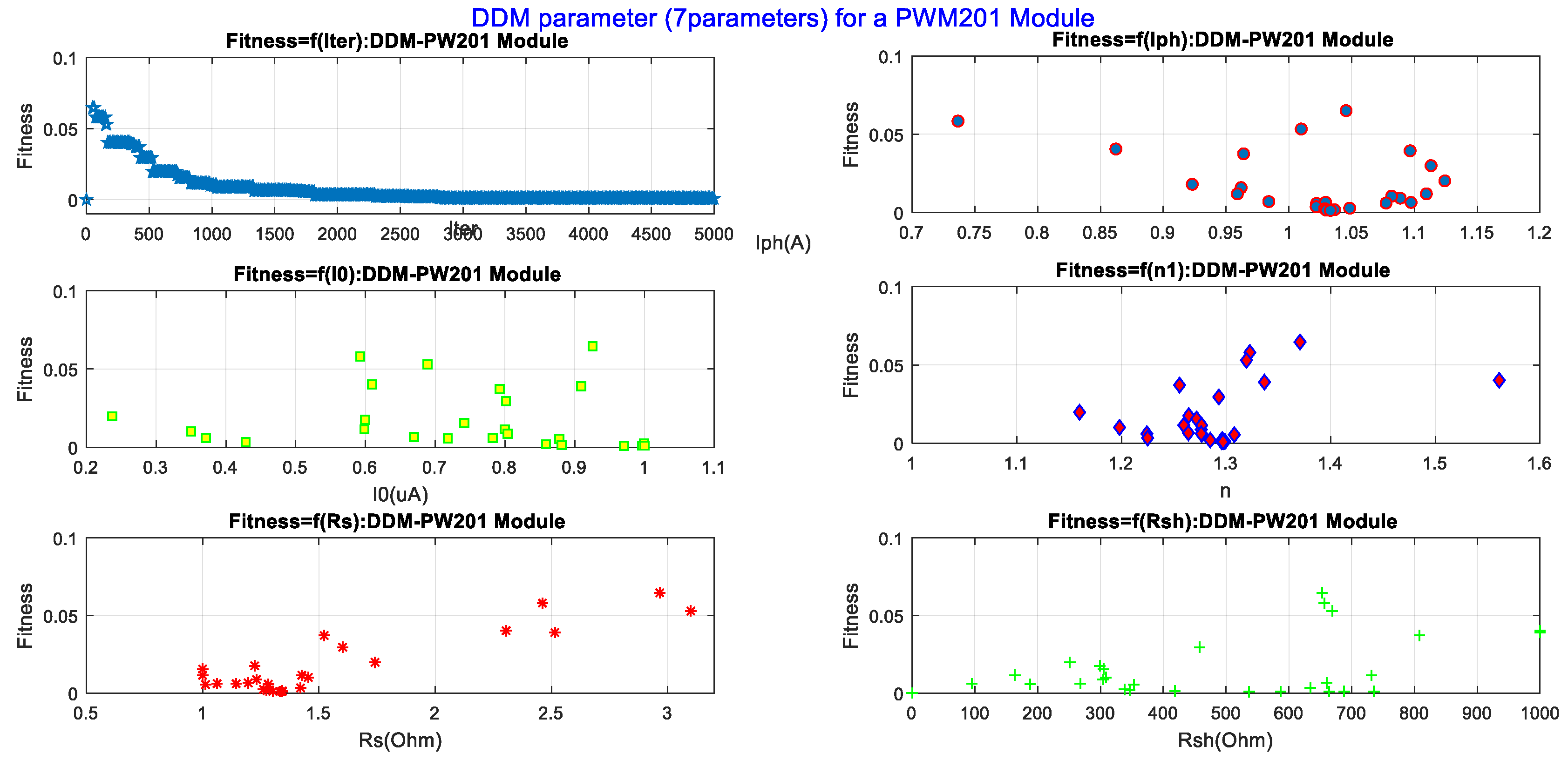
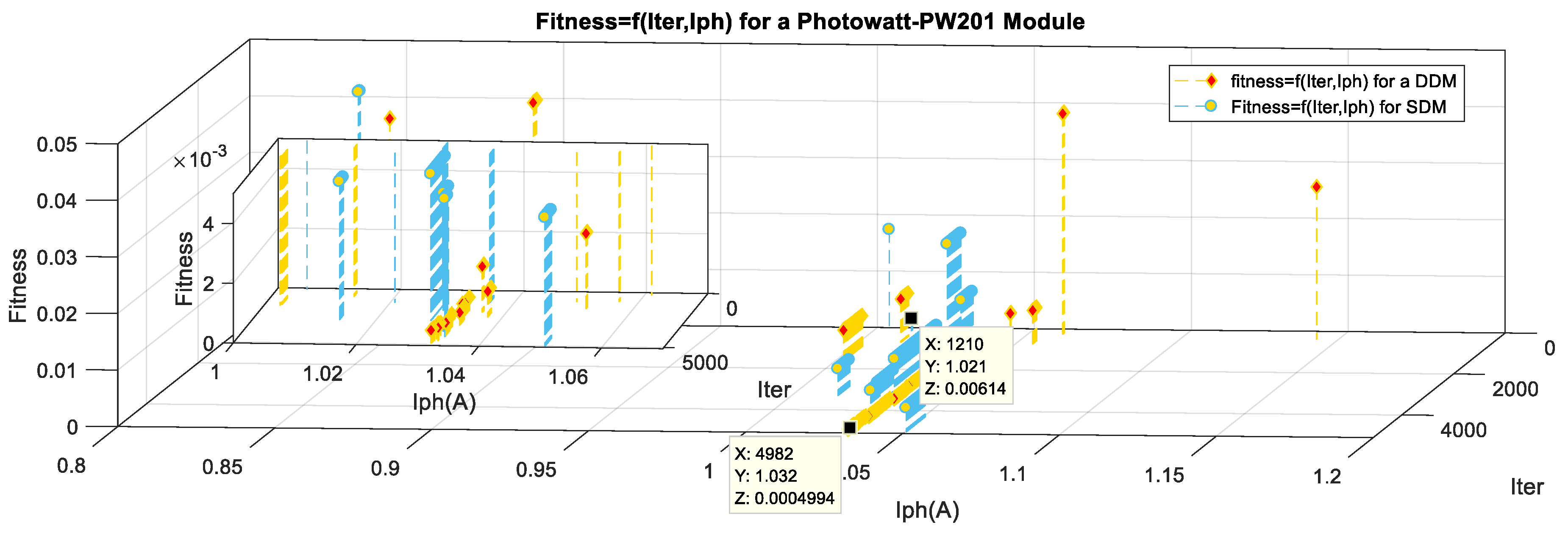
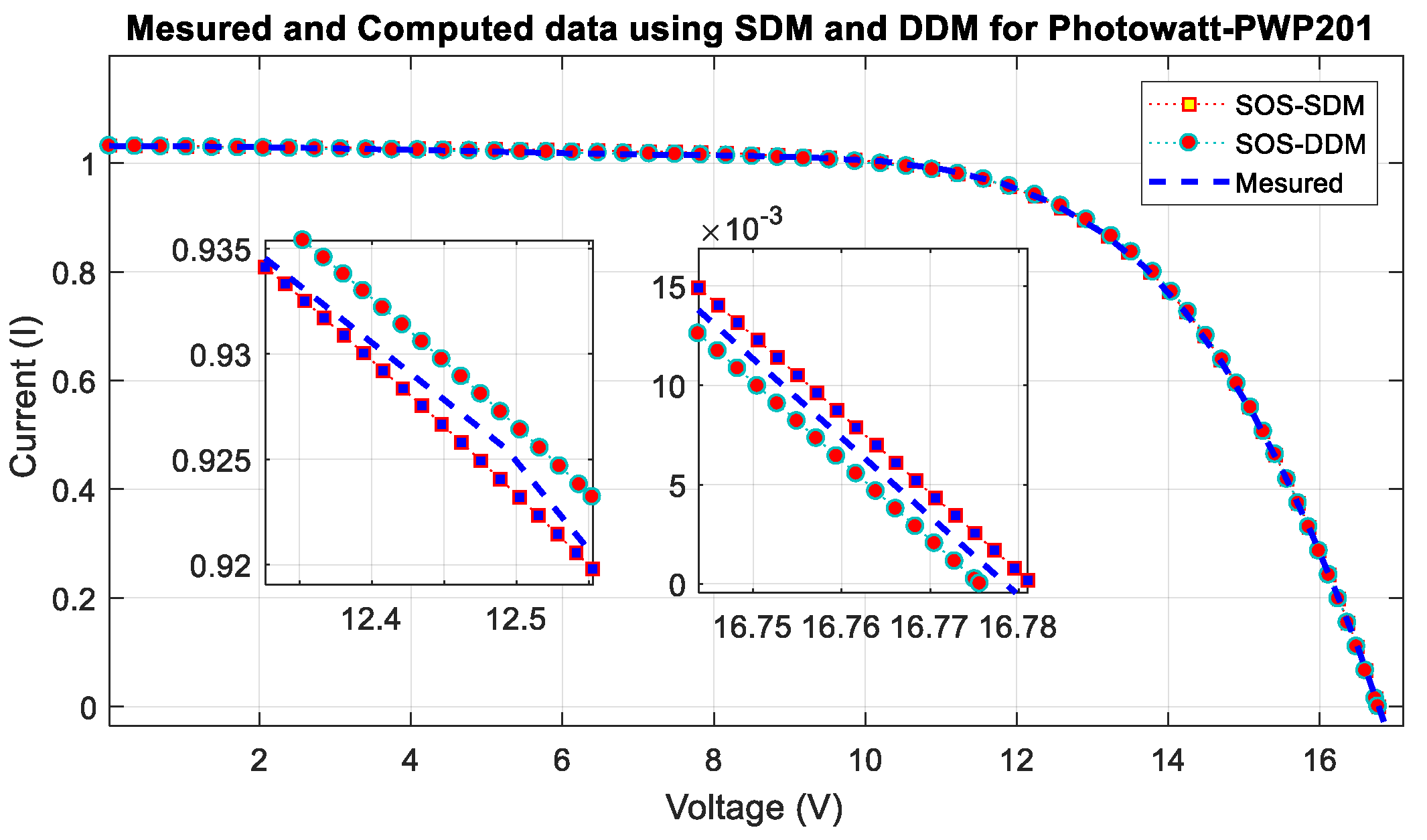
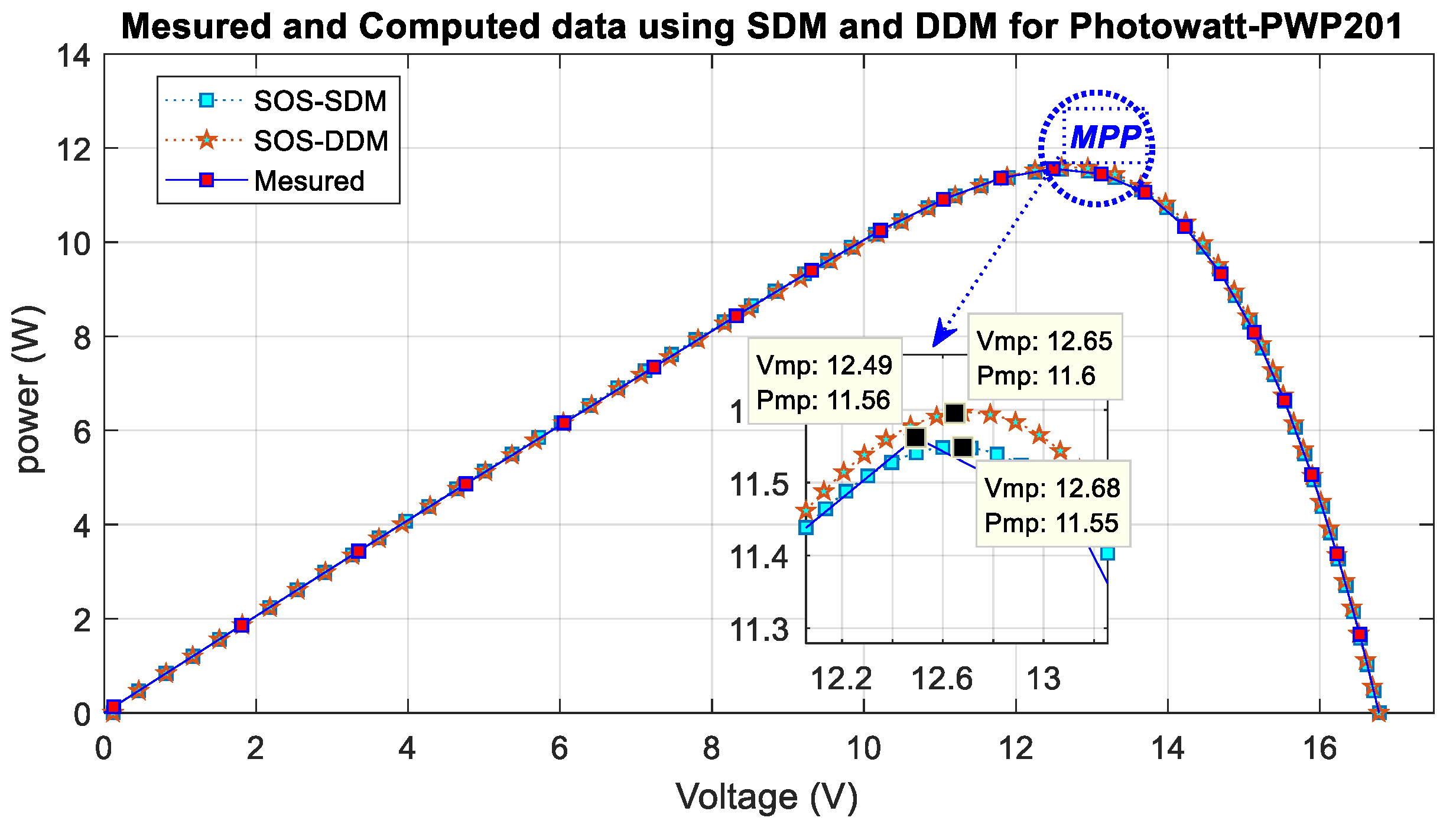

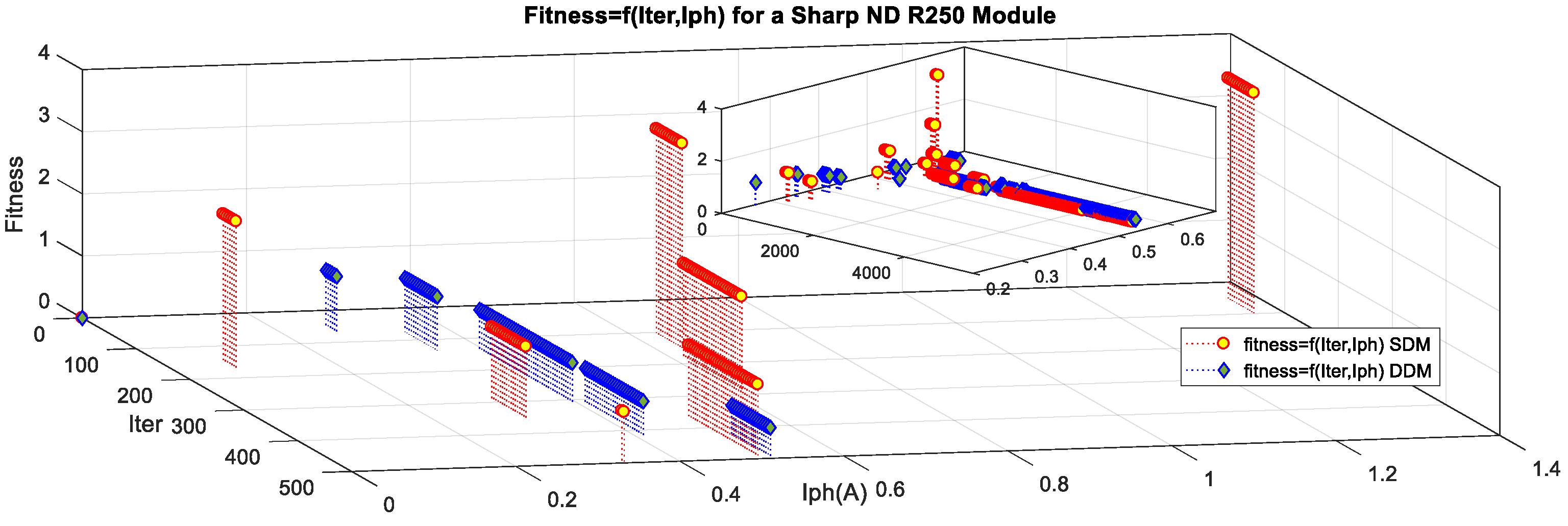
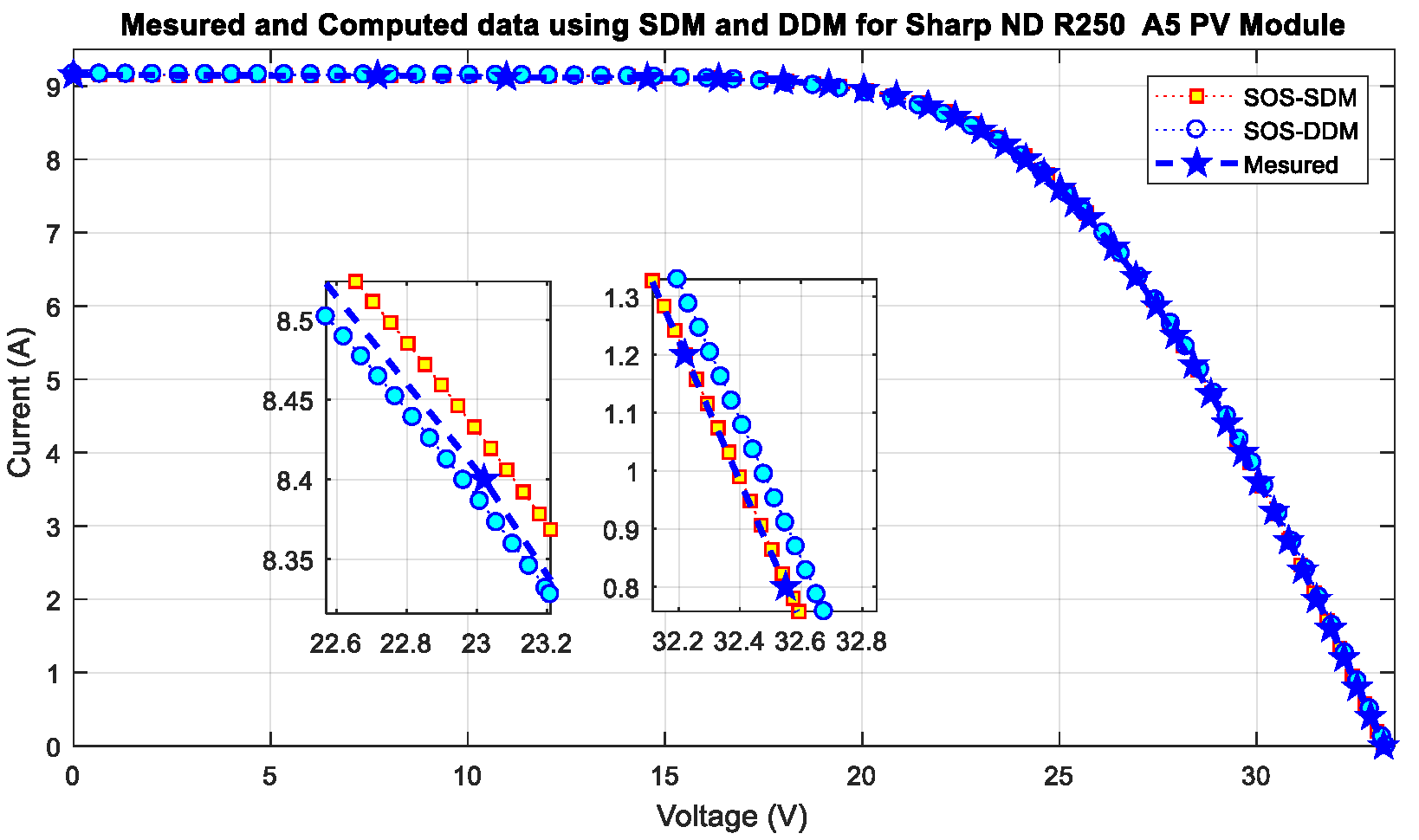
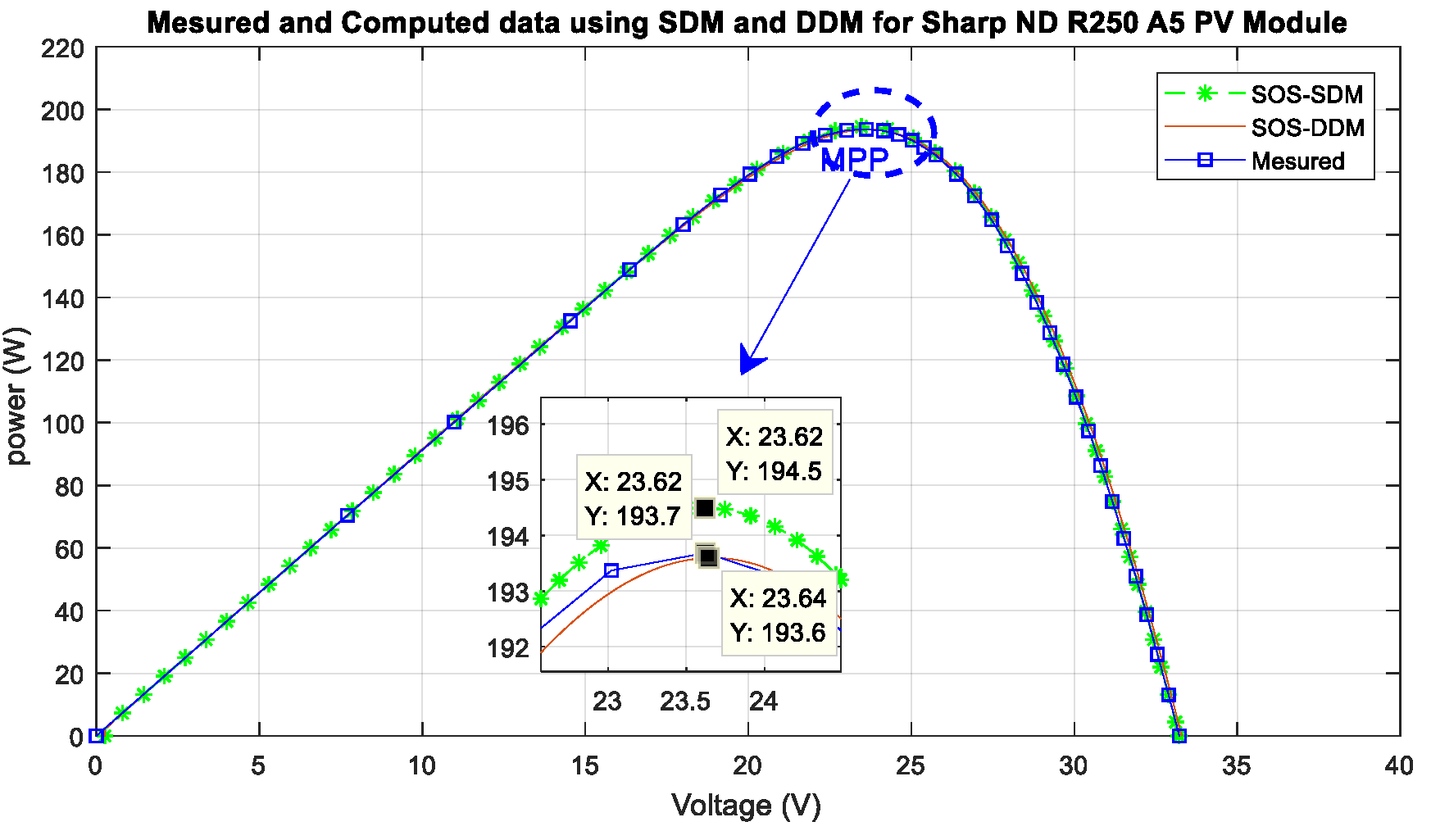
| Cell (33 °C) | Module (45 °C) | |
|---|---|---|
| Iph (A) | 0.7608 | 1.0318 |
| Is (A) | 0.3223 | 3.2876 |
| Gsh (£−1) | 0.0186 | 0.0018 |
| Rs (£−) | 0.0364 | 1.2057 |
| n | 1.4837 | 48.4500 |
| 0.6251 | 0.7805 | |
| Isc (A) | 0.7603 | 1.0300 |
| Voc (V) | 0.5728 | 16.7780 |
| Vm (V) | 0.4507 | 12.6790 |
| Im (A) | 0.6894 | 0.9120 |
| FF | 0.7135 | 0.6680 |
| N° | Vimes (V) | Iimes (A) | (DOSE) | IAE ‘DSOS’ | D (%) | IAE LMSA | IAE GGHS | IAE ABSO | IAE CPSO |
|---|---|---|---|---|---|---|---|---|---|
| 1 | −0.2057 | 0.7640 | 0.7661000 | 0.002100 | −0.013 | 11.5761 × 10−5 | 25.4092 × 10−5 | 19.9357 × 10−5 | 27.2179 × 10−5 |
| 2 | −0.1291 | 0.7620 | 0.7631000 | 0.001100 | −0.091 | 68.0671 × 10−5 | 81.1919 × 10−5 | 73.5839 × 10−5 | 43.0953 × 10−5 |
| 3 | −0.0588 | 0.7605 | 0.7611000 | 0.000600 | −0.118 | 86.3281 × 10−5 | 98.8025 × 10−5 | 89.2356 × 10−5 | 74.0421 × 10−5 |
| 4 | 0.0057 | 0.7605 | 0.7602720 | 0.000228 | 0.039 | 34.6856 × 10−5 | 22.8090 × 10−5 | 34.1728 × 10−5 | 35.3308 × 10−5 |
| 5 | 0.0646 | 0.7600 | 0.7591460 | 0.000854 | 0.118 | 95.3669 × 10−5 | 84.0396 × 10−5 | 97.0345× 10−5 | 85.4218 × 10−5 |
| 6 | 0.1185 | 0.7590 | 0.7585000 | 0.000500 | 0.132 | 97.3813 × 10−5 | 86.5670 × 10−5 | 101.025 × 10−5 | 77.8602 × 10−5 |
| 7 | 0.1678 | 0.7570 | 0.7575000 | 0.000500 | −0.013 | 69.0271 × 10−5 | 17.2188× 10−5 | 1.50171 × 10−5 | 34.8729 × 10−5 |
| 8 | 0.2132 | 0.7570 | 0.7562120 | 0.000788 | 0.119 | 88.6778 × 10−5 | 78.8905 × 10−5 | 95.5786 × 10−5 | 53.6411 × 10−5 |
| 9 | 0.2545 | 0.7555 | 0.7560000 | 0.000500 | 0.051 | 44.53071× 10−5 | 35.3713× 10−5 | 52.5346× 10−5 | 4.61184× 10−5 |
| 10 | 0.2924 | 0.7540 | 0.7541000 | 0.000100 | 0.040 | 37.01388× 10−5 | 28.7037× 10−5 | 45.5357 × 10−5 | 45.0681 × 10−5 |
| 11 | 0.3269 | 0.7505 | 0.7516000 | 0.001100 | −0.120 | 85.8429 × 10−5 | 92.9424 × 10−5 | 77.6748 × 10−5 | 124.115 × 10−5 |
| 12 | 0.3585 | 0.7465 | 0.7472610 | 0.000761 | −0.107 | 82.7345 × 10−5 | 88.1240 × 10−5 | 76.0912 × 10−5 | 111.361 × 10−5 |
| 13 | 0.3873 | 0.7385 | 0.7392600 | 0.000760 | −0.217 | 160.213 × 10−5 | 163.391 × 10−5 | 156.431 × 10−5 | 172.219 × 10−5 |
| 14 | 0.4137 | 0.7280 | 0.7285100 | 0.000510 | 0.082 | 61.6337 × 10−5 | 60.9190 × 10−5 | 61.3997 × 10−5 | 71.5867 × 10−5 |
| 15 | 0.4373 | 0.7065 | 0.7073010 | 0.000801 | −0.071 | 49.2923 × 10−5 | 47.9481 × 10−5 | 53.8447 × 10−5 | 17.5705 × 10−5 |
| 16 | 0.4590 | 0.6755 | 0.6753990 | 0.000101 | 0.015 | 18.2486 × 10−5 | 20.3482 × 10−5 | 10.3140 × 10−5 | 63.6238 × 10−5 |
| 17 | 0.4784 | 0.6320 | 0.6312000 | 0.000800 | 0.190 | 119.491 × 10−5 | 120.108 × 10−5 | 110.694 × 10−5 | 161.040 × 10−5 |
| 18 | 0.4960 | 0.5730 | 0.5730000 | 0.000000 | 0.140 | 102.652 × 10−5 | 99.2188 × 10−5 | 96.3482 × 10−5 | 118.099 × 10−5 |
| 19 | 0.5119 | 0.4990 | 0.4992000 | 0.000200 | −0.080 | 63.89021 × 10−5 | 73.4145 × 10−5 | 16.4603 × 10−5 | 94.8217 × 10−5 |
| 20 | 0.5265 | 0.4130 | 0.4141000 | 0.001100 | −0.097 | 65.7580 × 10−5 | 82.6002 × 10−5 | 243.286 × 10−5 | 158.721 × 10−5 |
| 21 | 0.5398 | 03165 | 0.3170100 | 0.000510 | −0.221 | 99.2379 × 10−5 | 122.715 × 10−5 | 18.4533 × 10−5 | 255.847 × 10−5 |
| 22 | 0.5521 | 0.2120 | 0.2121610 | 0.000161 | −0.236 | 11.2783 × 10−5 | 39.2380 × 10−5 | 15.6971 × 10−5 | 222.111 × 10−5 |
| 23 | 0.5633 | 0.1035 | 0.1022000 | 0.001300 | 0.870 | 130.599 × 10−5 | 102.001 × 10−5 | 154.636 × 10−5 | 111.047 × 10−5 |
| 24 | 0.5736 | −0.010 | −0.009230 | 0.000770 | 3.000 | 122.858 × 10−5 | 146.201 × 10−5 | 103.23 × 10−5 | 354.617 × 10−5 |
| 25 | 0.5833 | −0.123 | −0.124300 | 0.001300 | −0.894 | 254.525 × 10−5 | 240.977 × 10−5 | 272.460 × 10−5 | 61.7820 × 10−5 |
| 26 | 0.590 | −0.21 | −0.20750 | 0.00250 | 0.334 | 152.25 × 10−5 | 152.95 × 10−5 | 155.92 × 10−5 | 273.84 × 10−5 |
| Iph (A) | I0 () | n | Rs (£) | Rsh (£) | SSE | RMSE | ||
|---|---|---|---|---|---|---|---|---|
| GA [49] | 0.76190 | 0.80870 | 1.57510 | 0.02990 | 42.3729 | 9.4632 × 10−3 | 1.9078 × 10−2 | 2.51 × 10−2 |
| SA [50] | 0.76200 | 0.47980 | 1.51720 | 0.03450 | 43.1034 | 9.3839 × 10−3 | 1.8998 × 10−2 | 2.50 × 10−2 |
| PS [51] | 0.76170 | 0.99800 | 1.60000 | 0.03130 | 64.1026 | 5.8005 × 10−3 | 1.4936 × 10−2 | 1.96 × 10−2 |
| NR [47] | 0.76080 | 0.32230 | 1.48370 | 0.03640 | 53.7634 | 2.4445 × 10−3 | 9.6964 × 10−3 | 1.28 × 10−2 |
| DE [52] | 0.76080 | 0.32300 | 1.48060 | 0.03640 | 53.7185 | 1.4265 × 10−4 | 2.3423 × 10−3 | 3.08 × 10−3 |
| CPSO [53] | 0.76070 | 0.40000 | 1.50330 | 0.03540 | 59.0120 | 4.9952 × 10−5 | 1.3861 × 10−3 | 1.82 × 10−3 |
| ABSO [38] | 0.76080 | 0.30620 | 1.47580 | 0.03660 | 52.2903 | 2.5547 × 10−5 | 9.9124 × 10−4 | 1.30 × 10−3 |
| GGHS [54] | 0.76090 | 0.32620 | 1.48220 | 0.03630 | 53.0647 | 2.5528 × 10−5 | 9.9097 × 10−4 | 1.30 × 10−3 |
| LMSA [34] | 0.76078 | 0.31849 | 1.47976 | 0.03643 | 53.3264 | 2.5297 × 10−5 | 9.8640 × 10−4 | 1.30 × 10−3 |
| IADE [55] | 0.76070 | 0.33613 | 1.48520 | 0.03621 | 54.7643 | 9.8900 × 10−4 | 6.1706 × 10−3 | 8.12 × 10−3 |
| TLBO [42] | 0.76074 | 0.32378 | 1.48136 | 0.03641 | 54.4029 | 9.8845 × 10−4 | 6.1689 × 10−3 | 8.11 × 10−3 |
| STLBO [42] | 0.76078 | 0.32302 | 1.48114 | 0.03638 | 53.7187 | 9.8602 × 10−4 | 6.1613 × 10−3 | 8.10 × 10−3 |
| DSOS (current Method) | 0.759533 | 0.195478 | 1.4526 | 0.0392996 | 72.7785 | 1.20836 × 10−5 | 4.5918 × 10−4 | 3.48943 × 10−3 |
| Parameters | Iph (A) | n | Rs (£) | Rsh (£) | |
|---|---|---|---|---|---|
| Lower | 0.5 | 0 | 1 | 0 | 50 |
| Upper | 1 | 0.5 | 1.5 | 0.5 | 100 |
| N° | Vi (V) | Ii (A) | Îcal ‘DSOS’ | IAE ‘DSOS’ | D (%) | IAE “PS” | IAE “GA” | IAE “Bouzidi” |
|---|---|---|---|---|---|---|---|---|
| 1 | −1.9426 | 1.0345 | 1.033 | 0.00150 | 0.184 | --- | --- | --- |
| 2 | 0.1248 | 1.0315 | 1.031 | 0.00050 | 0.126 | 0.002135 | 0.010190 | 7.7476 × 10−5 |
| 3 | 1.8093 | 1.0300 | 1.028 | 0.002000 | 0.175 | 0.003030 | 0.00869848 | 0.00164534 |
| 4 | 3.3511 | 1.0260 | 1.0262 | 0.000200 | −0.029 | 0.001267 | 0.00991153 | 0.00049525 |
| 5 | 4.7622 | 1.0220 | 1.024 | 0.002000 | −0.235 | 0.000558 | 0.01122849 | 0.00077184 |
| 6 | 6.0538 | 1.0180 | 1.022 | 0.004000 | −0.432 | 0.002262 | 0.01245763 | 0.00197105 |
| 7 | 7.2364 | 1.0155 | 1.02 | 0.004500 | −0.433 | 0.001986 | 0.01172839 | 0.00124347 |
| 8 | 8.3189 | 1.0140 | 1.016 | 0.002000 | −0.217 | 0.000419 | 0.008880327 | 0.00155399 |
| 9 | 9.3097 | 1.0100 | 1.0123 | 0.002300 | −0.020 | 0.002528 | 0.00632724 | 0.00398586 |
| 10 | 10.2163 | 1.0035 | 1.001 | 0.002500 | 0.309 | 0.006023 | 0.00237690 | 0.00772169 |
| 11 | 11.0449 | 0.9880 | 0.9852 | 0.002800 | 0.364 | 0.006603 | 0.00133367 | 0.00844289 |
| 12 | 11.8018 | 0.9630 | 0.9608 | 0.002200 | 0.363 | 0.006499 | 0.00097747 | 0.00836817 |
| 13 | 12.4929 | 0.9255 | 0.9245 | 0.001000 | 0.270 | 0.005437 | 0.00160795 | 0.00721723 |
| 14 | 13.1231 | 0.8725 | 0.8742 | 0.001700 | −0.012 | 0.002350 | 0.00432213 | 0.00393147 |
| 15 | 13.6983 | 0.8075 | 0.8086 | 0.00110 | 0.012 | 0.002308 | 0.00407491 | 0.00359833 |
| 16 | 14.2221 | 0.7265 | 0.7286 | 0.00210 | −0.220 | 0.000119 | 0.00630370 | 0.00082416 |
| 17 | 14.6995 | 0.6345 | 0.6363 | 0.00175 | −0.331 | 0.001255 | 0.00732234 | 0.00068144 |
| 18 | 15.1346 | 0.5345 | 0.5347 | 0.00020 | −0.243 | 0.000617 | 0.00662565 | 0.00040412 |
| 19 | 15.5311 | 0.4275 | 0.4272 | 0.00030 | −0.327 | 0.001154 | 0.00712186 | 0.00126106 |
| 20 | 15.8929 | 0.3185 | 0.3167 | 0.00180 | −0.063 | 0.000390 | 0.00553537 | 1.3616 × 10−5 |
| 21 | 16.2229 | 0.2085 | 0.2059 | 0.00260 | 0.336 | 0.001615 | 0.00423231 | 0.00103447 |
| 22 | 16.5241 | 0.1010 | 0.0966 | 0.000444 | 2.673 | 0.005205 | 0.00052532 | 0.0044828 |
| 23 | 16.7987 | −0.008 | −0.0095 | 0.00148 | −2.500 | 0.000561 | 0.00495155 | 0.00022555 |
| 24 | 17.0499 | −0.111 | −0.1116 | 0.00060 | 0 | 0.000051 | 0.00524400 | 0.00075112 |
| 25 | 17.2793 | −0.209 | −0.2089 | 0.00010 | −0.048 | 0.000244 | 0.00470115 | 0.00052498 |
| 26 | 17.4885 | −0.303 | −0.3009 | 0.00210 | 0.330 | 0.002267 | 0.00683625 | 0.00295655 |
| Iph(A) | n | Rs (£) | Rsh (£) | RMSE | |||
|---|---|---|---|---|---|---|---|
| GA [56] | 1.0441 | 3.4360 | 1.34962 | 1.1968 | 555.556 | Nc | Nc |
| PS [56] | 1.0313 | 3.1756 | 1.34136 | 1.2053 | 714.286 | 0.0118 | 1.96 × 10−2 |
| El Nagaar [51] | 1.0331 | 3.6642 | 1.35614 | 1.1989 | 833.333 | 2.9251 × 10−3 | 2.48 × 10−3 |
| Peng [57] | 1.0313 | 3.2212 | 1.34228 | 1.2132 | 625.000 | 6.3448 × 10−0.3 | 7.49 × 10−3 |
| Cong [58] | 1.0305 | 3.4823 | 1.35118 | 1.2013 | 981.982 | 2.266 × 10−3 | 2.20 × 10−3 |
| Bouzidi [59] | 1.0339 | 3.0760 | 1.33850 | 1.2030 | 555.556 | 4.0067 × 10−3 | 3.89 × 10−3 |
| Al Hajri [51] | 1.0313 | 3.1756 | 1.34135 | 1.2053 | 714.286 | 3.3269 × 10−3 | 3.23 × 10−3 |
| Phang [8] | 1.0319 | 64.0490 | 1.76024 | 0.0832 | 561.034 | 3.5432 × 10−3 | 3.44 × 10−2 |
| Cubas [48] | 1.0342 | 1.3214 | 1.25543 | 1.3535 | 559.680 | 2.9355 × 10−3 | 2..85 × 10−3 |
| (DSOS) | 1.0338 | 3.1488 | 1.4139 | 1.2135 | 773.380 | 5.752 × 10−4 | T = 259 ms |
| Parameters | Iph (A) | n | Rs (£) | Rsh (£) | |
|---|---|---|---|---|---|
| Lower | 0.01 | 0.01 | 0.01 | 0.001 | 0.001 |
| Upper | 1.2 | 5 | 2 | 2 | 5000 |
| N° | Vi(V) | Ii(A) | Ical (DSOS) | IAE (DSOS) | Ical (GCPSO) | IAE (GCPSO) |
|---|---|---|---|---|---|---|
| 1 | 0.000 | 9.1500 | 9.1458000 | 0.00422953 | 9.14377047 | 0.00622953 |
| 2 | 7.7100 | 9.1400 | 9.1399000 | 0.00013317 | 9.14168233 | 0.00168233 |
| 3 | 10.9800 | 9.1200 | 9.12596243 | 0.00596243 | 9.13887739 | 0.01887739 |
| 4 | 14.5500 | 9.1100 | 9.1134749 | 0.0034749 | 9.12574851 | 0.01574851 |
| 5 | 16.3600 | 9.1000 | 9.10148715 | 0.00148715 | 9.10450087 | 0.00450087 |
| 6 | 18.0000 | 9.0700 | 9.06698347 | 0.00301653 | 9.06239347 | 0.00831337 |
| 7 | 19.1500 | 9.0200 | 9.01188479 | 0.00811521 | 9.00539847 | 0.01460153 |
| 8 | 20.0400 | 8.9500 | 8.94512790 | 0.00487210 | 8.93702852 | 0.01297148 |
| 9 | 20.8700 | 8.8600 | 8.85488479 | 0.00511521 | 8.84484259 | 0.01515741 |
| 10 | 21.6700 | 8.7300 | 8.72377676 | 0.00622240 | 8.72087510 | 0.00912490 |
| 11 | 22.3600 | 8.5800 | 8.5784094 | 0.00119060 | 8.57859883 | 0.00140117 |
| 12 | 23.0200 | 8.4000 | 8.4005014 | 0.00058140 | 8.40537373 | 0.00537373 |
| 13 | 23.6200 | 8.2000 | 8.2058125 | 0.00581250 | 8.21159590 | 0.01159590 |
| 14 | 24.1500 | 8.0000 | 8.0031538 | 0.00315380 | 8.00863240 | 0.00863240 |
| 15 | 24.6100 | 7.8000 | 7.8009372 | 0.00093720 | 7.80668549 | 0.00668549 |
| 16 | 25.0200 | 7.6000 | 7.5997143 | 0.00028570 | 7.60570866 | 0.00570866 |
| 17 | 25.3900 | 7.4000 | 7.4008003 | 0.00080030 | 7.40703581 | 0.00703581 |
| 18 | 25.7500 | 7.2000 | 7.1976296 | 0.00237040 | 7.19787656 | 0.00212344 |
| 19 | 26.3800 | 6.8000 | 6.7945823 | 0.00341770 | 6.79445213 | 0.00554787 |
| 20 | 26.9400 | 6.4000 | 6.3962879 | 0.000361210 | 6.39677884 | 0.00322116 |
| 21 | 27.4600 | 6.0000 | 5.99992389 | 0.00007611 | 5.99588450 | 0.00411550 |
| 22 | 27.9400 | 5.6000 | 5.5990248 | 0.00097520 | 5.60010457 | 0.00010457 |
| 23 | 28.4000 | 5.2000 | 5.198805 | 0,0015950 | 5.19888971 | 0.00111029 |
| 24 | 28.8400 | 4.8000 | 4.7967827 | 0.0022173 | 4.79618216 | 0.00381784 |
| 25 | 29.2500 | 4.4000 | 4.3968621 | 0.0011379 | 4.40523919 | 0.00523919 |
| 26 | 29.6600 | 4.0000 | 3.99991486 | 0.00008514 | 4.00005387 | 0.00005387 |
| 27 | 30.0500 | 3.6000 | 3.597963 | 0.00203700 | 3.60219710 | 0.00219710 |
| 28 | 30.4400 | 3.2000 | 3.1934659 | 0.00643410 | 3.19293749 | 0.00706251 |
| 29 | 30.8100 | 2.8000 | 2.796529 | 0.00437100 | 2.79474323 | 0.00525677 |
| 30 | 31.1700 | 2.4000 | 2.398787 | 0.00121300 | 2.39857399 | 0.00142601 |
| 31 | 31.5200 | 2.0000 | 1.99631505 | 0.00218495 | 2.00561158 | 0.00561158 |
| 32 | 31.8800 | 1.6000 | 1.5985872 | 0,0012128 | 1.59394801 | 0.00615199 |
| 33 | 32.2200 | 1.2000 | 1.19897656 | 0.00102344 | 1.19829368 | 0.00170632 |
| 34 | 32.5500 | 0.8000 | 0.79895766 | 0.00102340 | 0.80851159 | 0.00851159 |
| 35 | 32.8900 | 0.4000 | 0.39146489 | 0.008535110 | 0.40119395 | 0.00119395 |
| 36 | 33.2200 | 0.0000 | −0.00047210 | 0.00047210 | 0.00058606 | 0.00058606 |
| Iph(A) | N | Rs (£) | Rsh (£) | RMSE | |||
|---|---|---|---|---|---|---|---|
| GCPSO [3] | 9.144865 | 0.99585 | 1.206579 | 0.59187049 | 4999.9999 | 7.697717 × 10−3 | 8.86834 × 10−4 |
| DSOS | 9.150421 | 0.99557 | 1.328 | 0.58387 | 3000 | 3.5162 × 10−3 | 4.05092 × 10−4 |
| Iph(A) | n1 | n2 | Rs (£) | Rsh (£) | RMSE | ||||
|---|---|---|---|---|---|---|---|---|---|
| CWOA [44] | 0.76077 | 0.24150 | 0.6000 | 1.4565 | 1.9899 | 0.03666 | 55.2016 | 9.8272 × 10−4 | 1.2925 × 10−3 |
| SA [50] | 0.7623 | 0.4767 | 0.0100 | 1.51720 | 2.0000 | 0.03450 | 43.1034 | 1.8998 × 10−2 | 2.50 × 10−2 |
| PS [51] | 0.76170 | 0.99800 | 0.0001 | 1.60000 | 1.1920 | 0.03130 | 64.1026 | 1.4936 × 10−2 | 1.96 × 10−2 |
| HS [54] | 0.76176 | 0.12545 | 0.25470 | 1.49439 | 1.49989 | 0.03545 | 46.82696 | 0.001260 | 1.28 × 10−2 |
| BFA [60] | 0.76090 | 0.09400 | 0.04530 | 1.3809 | 1.5255 | 0.03510 | 60.0000 | 1.2000 × 10−3 | 3.08 × 10−3 |
| CPSO [53] | 0.76078 | 0.22732 | 0.72785 | 1.45151 | 1.99769 | 0.03540 | 59.0120 | 1.3861 × 10−3 | 1.82 × 10−3 |
| ABSO [38] | 0.76080 | 0.30620 | 0.38191 | 1.47580 | 1.98152 | 0.03660 | 52.2903 | 9.9124 × 10−4 | 1.30 × 10−3 |
| GGHS [54] | 0.76090 | 0.32620 | 0.13504 | 1.48220 | 1.92009 | 0.03630 | 53.0647 | 9.9097 × 10−4 | 1.30 × 10−3 |
| ABC [44] | 0.7608 | 0.04070 | 0.28740 | 1.44950 | 1.48850 | 0.03640 | 53.78040 | 9.8610 × 10−4 | 1.2969 × 10−3 |
| IADE [55] | 0.76070 | 0.33613 | 0.03674 | 1.48520 | 2.0000 | 0.03621 | 54.7643 | 6.1706 × 10−3 | 8.12 × 10−3 |
| TLBO [42] | 0.76074 | 0.32378 | 1.448974 | 1.48136 | 1.99997 | 0.03641 | 54.4029 | 6.1689 × 10−3 | 8.11 × 10−3 |
| STLBO [42] | 0.76078 | 0.32302 | 0.036740 | 1.48114 | 2.0000 | 0.03638 | 53.7187 | 6.1613 × 10−3 | 8.10 × 10−3 |
| DSOS | 0.76348 | 0.37497 | 0.0410 | 1.51932 | 1.86743 | 0.03603 | 37.0405 | 5.3308 × 10−3 | 7.011 × 10−3 |
| Parameters | Iph (A) | n1 | n2 | Rs (£) | Rsh (£) | ||
|---|---|---|---|---|---|---|---|
| Lower | 0 | 0.001 | 0.001 | 0.5 | 0.5 | 0.001 | 0.01 |
| Upper | 1 | 1 | 1 | 2 | 2 | 1 | 100 |
| Iph(A) | n1 | n2 | Rs (£) | Rsh (£) | RMSE | ||||
|---|---|---|---|---|---|---|---|---|---|
| GCPSO [3] | 1.03238 | 2.51292 | 1.00 × 10−6 | 1.317304 | 1.31694 | 1.23928 | 744.7154 | 2.04653 × 10−3 | 1.9869 × 10−3 |
| DSOS | 1.03361 | 0.9993 | 0.337913 | 1.298703 | 1.64699 | 1.30577 | 536.8256 | 8.6097 × 10−4 | 1.96699 × 10−3 |
| Parameters | Iph (A) | n1 | n2 | Rs (£) | Rsh (£) | ||
|---|---|---|---|---|---|---|---|
| Lower | 0.1 | 1 × 10−6 | 1 × 10−6 | 1 | 1 | 1 | 1 |
| Upper | 2 | 1 | 1 | 2 | 3 | 5 | 1000 |
| Iph(A) | n1 | n2 | Rs (£) | Rsh (£) | RMSE | ||||
|---|---|---|---|---|---|---|---|---|---|
| GCPSO [3] | 1.03238 | 2.51292 | 1.0× 10−6 | 1.317304 | 1.31694 | 1.23928 | 744.7154 | 2.046× 10−3 | 1.98× 10−3 |
| SOS | 9.16851 | 1.59997 | 0.9999 | 1.37237 | 1.62591 | 0.56772 | 795.6674 | 76.12× 10−3 | 8.77× 10−3 |
| Parameters | Iph (A) | n1 | n2 | Rs (£) | Rsh (£) | ||
|---|---|---|---|---|---|---|---|
| Lower | 8 | 1 | 0.1 | 1 | 1 | 0.1 | 100 |
| Upper | 10 | 2 | 1 | 2 | 2 | 1 | 1000 |
| p < 5% | LMSA | GGHS | ABSO | CPSO | (R-T-C France Photo Cell) |
| SDM | 0.010805 | 0.009335 | 0.010805 | 0.01834 | p value one tail |
| 0.026110 | 0.01867 | 0.021611 | 0.02669 | p value two tails | |
| p < 5% | PS | GA | Bouzidi | (Photowatt-PWP201 PV Module) | |
| SDM | 0.022649 | 1.8604 × 10−6 | 0.044380 | p value one tail | |
| 0.045298 | 3.7208 × 10−6 | 0.008876 | p value two tails | ||
| p < 5% | GCPSO | (Sharp ND R250 A5 PV Module) | |||
| SDM | 0.0012979 | p value one tail | |||
| 0.0025959 | p value two tails | ||||
© 2019 by the authors. Licensee MDPI, Basel, Switzerland. This article is an open access article distributed under the terms and conditions of the Creative Commons Attribution (CC BY) license (http://creativecommons.org/licenses/by/4.0/).
Share and Cite
Bouali, C.; Schulte, H.; Mami, A. A High Performance Optimizing Method for Modeling Photovoltaic Cells and Modules Array Based on Discrete Symbiosis Organism Search. Energies 2019, 12, 2246. https://doi.org/10.3390/en12122246
Bouali C, Schulte H, Mami A. A High Performance Optimizing Method for Modeling Photovoltaic Cells and Modules Array Based on Discrete Symbiosis Organism Search. Energies. 2019; 12(12):2246. https://doi.org/10.3390/en12122246
Chicago/Turabian StyleBouali, Chaabane, Horst Schulte, and Abdelkader Mami. 2019. "A High Performance Optimizing Method for Modeling Photovoltaic Cells and Modules Array Based on Discrete Symbiosis Organism Search" Energies 12, no. 12: 2246. https://doi.org/10.3390/en12122246
APA StyleBouali, C., Schulte, H., & Mami, A. (2019). A High Performance Optimizing Method for Modeling Photovoltaic Cells and Modules Array Based on Discrete Symbiosis Organism Search. Energies, 12(12), 2246. https://doi.org/10.3390/en12122246







